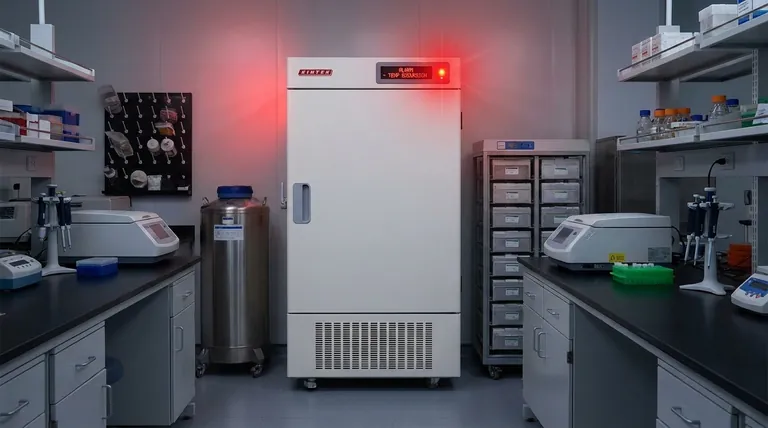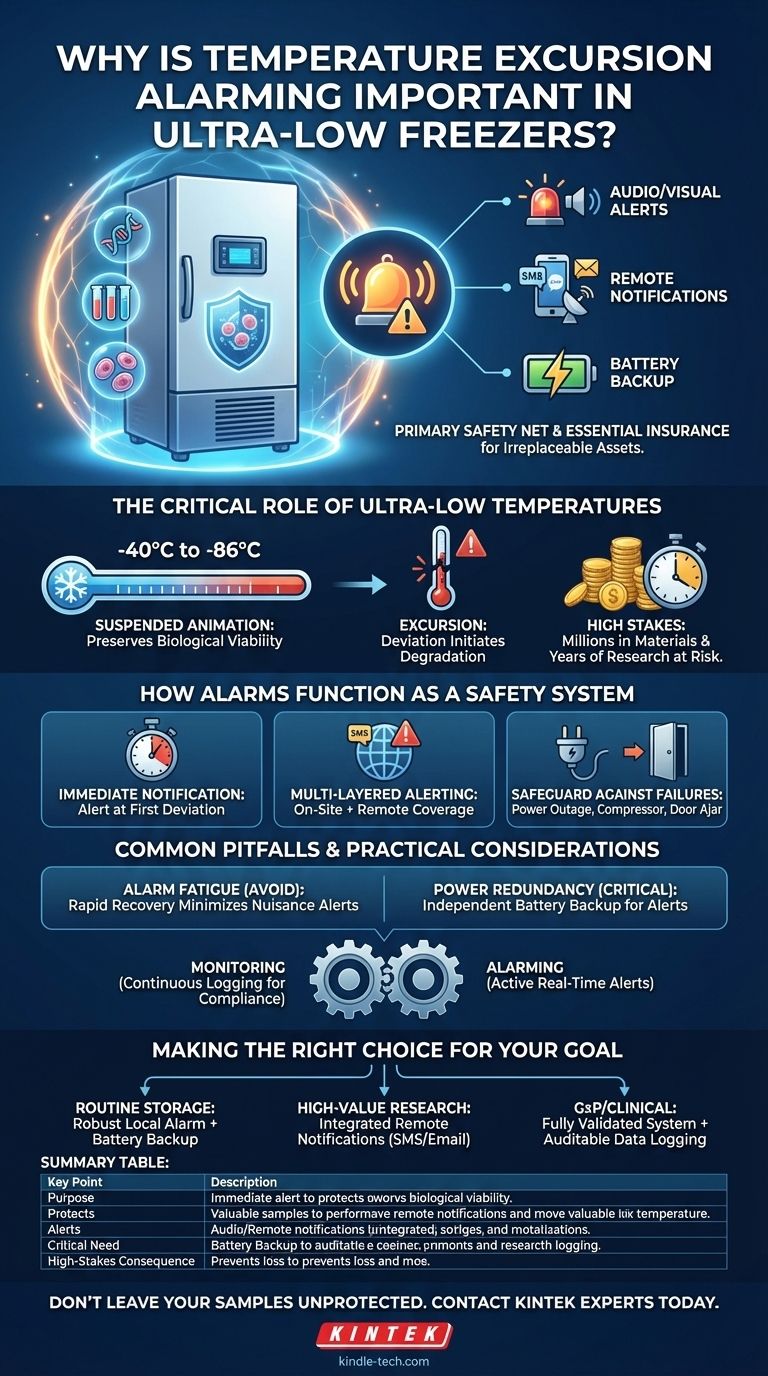At its core, a temperature excursion alarm is the primary safety net for your most valuable assets. In an ultra-low temperature (ULT) freezer, this system provides immediate audio, visual, and often remote alerts the moment the internal temperature deviates from its critical set point. This function is non-negotiable for protecting the integrity and viability of irreplaceable biological materials stored within.
A ULT freezer doesn't just store samples; it preserves their biological function. A temperature excursion alarm is not merely a feature—it is the essential insurance policy against the catastrophic, irreversible loss of research, time, and investment.

The Critical Role of Ultra-Low Temperatures
To understand the alarm, you must first appreciate the environment it protects. ULT freezers are designed to create a state of suspended animation for sensitive biologicals.
Preserving Biological Viability
ULT freezers operate at temperatures from -40°C down to -86°C. These extreme conditions effectively halt all metabolic and enzymatic activity within samples like vaccines, DNA/RNA, tissues, and cell cultures, preserving them for years or even decades.
Defining a Temperature "Excursion"
An excursion is any deviation from the specified temperature range. Even a brief rise of a few degrees can be enough to initiate degradation, compromise sample integrity, and render years of work invalid.
The High Stakes of Temperature Failure
The contents of a ULT freezer can represent millions of dollars in materials and years of irreplaceable research. The loss of these samples due to an undetected temperature failure is a catastrophic event for any laboratory or clinical operation.
How Excursion Alarms Function as a Safety System
An alarm system is your first and often only notification that something is wrong, allowing for immediate intervention before total sample loss occurs.
Providing Immediate Notification
The alarm's primary function is to alert personnel the moment a deviation occurs. This immediacy is critical, as the window to save compromised samples can be very short.
Multi-Layered Alerting
Effective systems use multiple notification methods. Audible and visual alarms alert staff on-site, while remote notifications via email or text message are crucial for alerting off-site personnel to issues that occur overnight or during weekends.
Safeguarding Against System Failure
Excursions are caused by more than just component failure. An alarm will trigger for any number of reasons, including a prolonged power outage, a main compressor failure, or something as simple as a door not being fully sealed.
Common Pitfalls and Practical Considerations
A reliable alarm system is more than just a loud noise; it must be integrated intelligently to be effective without being a nuisance.
Alarm Fatigue and Nuisance Alerts
Frequent door openings will cause minor, temporary temperature fluctuations. A well-engineered freezer must have rapid temperature recovery capabilities to minimize these spikes and prevent them from triggering unnecessary alarms, which can lead to staff ignoring them over time.
The Need for Power Redundancy
The alarm system is most critical during a power failure. Therefore, the monitor and alarm must have their own battery backup to ensure they can function and send alerts even when the freezer itself is not powered.
Monitoring vs. Alarming
It's important to distinguish between these two functions. Monitoring involves continuously logging temperature data over time for compliance and analysis. Alarming is the active, real-time alert that is triggered by a specific event. A robust system requires both.
Making the Right Choice for Your Goal
Your alarm strategy should directly reflect the value and irreplaceability of your stored materials.
- If your primary focus is routine, replaceable sample storage: A robust local audio/visual alarm system with a dedicated battery backup is the essential minimum.
- If your primary focus is high-value, long-term research samples: You require a system with integrated remote notifications (SMS/email) to ensure 24/7 coverage, regardless of staff presence.
- If your primary focus is GxP compliance or clinical materials: You need a fully-validated system that combines real-time alarming with continuous, auditable data logging to prove an unbroken cold chain.
A reliable alarm system transforms your freezer from a simple storage unit into an actively protected biorepository.
Summary Table:
| Key Point | Description |
|---|---|
| Purpose | Immediate alert for temperature deviations in ultra-low freezers. |
| Protects | Valuable, irreplaceable biological samples (vaccines, tissues, DNA/RNA). |
| Alerts | Audio, visual, and remote notifications (SMS/email). |
| Critical Need | Battery backup for alarms during power failures. |
| High-Stakes Consequence | Prevents catastrophic loss of research, time, and investment. |
Don't leave your critical samples unprotected. A reliable temperature excursion alarm system is essential insurance for your laboratory's most valuable assets. KINTEK specializes in high-performance lab equipment, including ultra-low freezers and monitoring solutions, to ensure the integrity of your biological materials. Contact our experts today to find the perfect protection system for your research and storage needs.
Visual Guide

Related Products
- 108L Vertical Ultra Low Temperature ULT Freezer
- 508L Advanced Vertical Ultra Low Temperature Freezer for Critical Laboratory Storage
- 28L Compact Upright Ultra Low Temperature Freezer for Laboratory
- 708L Ultra Low Temperature Freezer High Performance Laboratory Freezer
- 208L Advanced Precision Laboratory Ultra Low Temperature Freezer for Cold Storage
People Also Ask
- What temperature range do Ultra-Low Temperature freezers maintain? The -80°C Standard for Sample Integrity
- What advantages do ultra-low temperature freezers offer? Ensure Long-Term Sample Integrity and Reliability
- How do Ultra-Low Temperature freezers ensure the integrity of microbiological samples? Maintain Stability for Critical Research
- What are the common designs of ultra-low temperature freezers? Upright vs. Chest Models for Your Lab
- What are ultra low temperature freezers used for? Preserving Critical Biological Samples for Decades



















